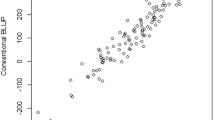Summary
Expanding the regression coefficient as stability parameter (Finlay and Wilkinson 1963) requires an unbiased interpretation of the parameter. Information on the covariances among the genotypes of the population must be specific, particularly when the assumed relatedness of the genotypes appears questionable. Such a problem, however, is not expected when the covariances between the genotypes are either zero or equal and possibly non zero.
Similar content being viewed by others
Literature
Breese, E.L.: The measurement and significance of genotype environment interactions in grasses. Heredity 24, 27–44 (1969)
Comstock, R.E.; Moll, R.H.: Genotype-environment interaction. In: Statistical Genetics and Plant Breeding (eds. Hanson, W.D.; Robinson, H.F.) pp. 164–196, Washington, D.C.: Nat. Acad. Sci., Nat. Res. Council 1963
Finlay, K.W.; Wilkinson, G.N.: The analysis of adaptation in a plant-breeding programme. Austr. J. Agric. Res. 14, 742–754 (1963)
Johnson, V.A.; Shafer, L.; Schmidt, J.W.: Regression analysis of general adaptation in hard red winter wheat (Triticum aestivum L.). Crop Sci. 8, 187–191 (1968)
Jowett, D.: Yield stability parameters for sorghum in East Africa. Crop Sci. 6, 314–317 (1972)
Knight, R.: The measurement and interpretation of genotype environment interactions. Euphytica 19, 225–235 (1970)
Liang, G.H.; Heyne, E.G.; Walter, T.L.: Estimate of variety X environmental interactions in yield tests of three small grains and their significance on the breeding programs. Crop Sci. 6, 135–139 (1966)
Perkins, J.M.; Jinks, J.L.: Environment and genotype-environmental components of variability. III. Multiple lines and crosses. Heredity 23, 339–356 (1968)
Perkins, J.M.; Jinks, J.L.: Specificity of the interaction of genotypes with contrasting environments. Heredity 26, 463–474 (1971)
Sprague, G.F.; Federer, W.T.: A comparison of variance components in corn yield trials. II. Error, year X variety, location X variety and variety components. Agron. J. 48, 535–541 (1951)
Witcombe, J.R.; Whittington, W.J.: A study of the genotype by environment interaction shown by germinating seeds of Brassica napus. Heredity 26, 397–411 (1971)
Yates, F.; Cochran, W.G.: The analysis of groups of experiments. J. Agric. Sci., Camb. 28, 556–580 (1938)
Author information
Authors and Affiliations
Additional information
Communicated by R.W. Allard
Rights and permissions
About this article
Cite this article
Miezan, K., Milliken, G.A. & Liang, G.H. Using regression coefficient as a stability parameter in plant breeding programs. Theoret. Appl. Genetics 54, 7–9 (1979). https://doi.org/10.1007/BF00265701
Received:
Accepted:
Issue Date:
DOI: https://doi.org/10.1007/BF00265701




